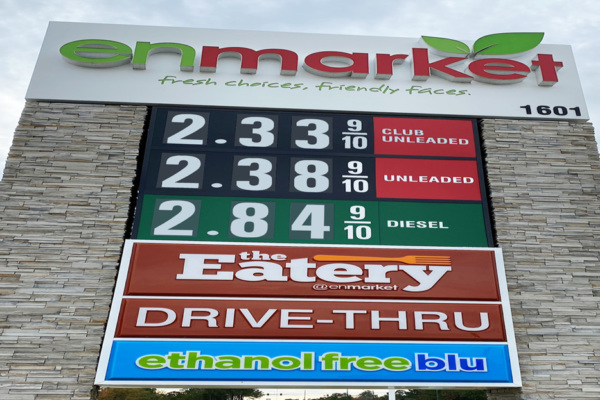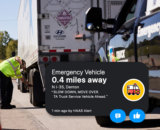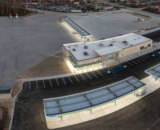Signs are critical to business operations. So much so that during the Covid-19 pandemic, the federal government designated sign manufacturers as critical infrastructure that needed to stay open when the rest of the world was shutting down.
Signage plays a critical role in helping businesses communicate with the general public. Illuminated roadside signage tells customers where a company is located. Directional signage in the parking lot lets them know where to go, and temporary signs inside the store could advertise specials or remind them to social distance.
“The importance of truckstop and travel plaza signs is as high as ever,” said David Hickey, vice president of advocacy at the International Sign Association. “Signs aren’t just used to make a business look nice. The main purpose is to attract business and grow impulse sales.”
He added that signs are the most effective, yet least expensive, form of advertising for the small business, according to the U.S. Small Business Administration. “There is extensive research confirming the value of signs,” Hickey said.
Hickey, along with Kenny Peskin, director of industry programs at the International Sign Association, participated in a NATSO webinar on signage. The event, Signage Best Practices for Truckstops and Travel Centers, was sponsored by Curzon Promotional Graphics.
Creating an Impression
Operators don’t need a sign that just looks good. “You want one that is robust and hearty and gives you value,” Peskin said.
A survey by Villanova University of 500 small businesses found that on-premise signs were the most cost-effective method of advertising. Billboards ranked second, followed by the radio, newspapers and television, Hickey said.
A shopper study by BrandSpark and Better Homes and Gardens found that 64 percent of respondents said they have failed to find a business because the signage was too small or unclear. The majority—76 percent—said one of the first things they notice about a new or unfamiliar business is the signage outside its building, and 84 percent said signs can convey the personality or character of the business.
“While you can’t judge a book by its cover, you should judge a business by a sign,” Hickey said.
Some things make signage hard to read, with 83 percent of respondents citing letters that are too small as an issue.
Branding the Business
Peskin explained the ABC's of signs. 'A' is for attracting new customers, 'B' is for branding your location, and 'C' is for creating impulse sales. “The real focus is on how you develop a marketing strategy and creative and attractive signs that can help the business stand apart,” Peskin said.
Customers like to purchase from a recognized business, and a sign can plant the seed for future sales. They can also get people inside and encourage them to buy more.
“Much of the incremental sales in food or snacks or general merchandise are the real drivers of profit,” Peskin said, adding that everything from a changeable coffee panel to digital displays to pump toppers can attract additional transactions or volume from the customers once they are on site.
The goal is for customers to recall a sign hours or days after having seen it. “You’re hoping your audience will invoke a positive relationship with the business,” Peskin said. “Your sign, when viewed, is a recognition of your product or brand in the mind of that person. It makes it easier to make that next sell if they remember you from the previous association.”
Operators should consider how a sign will contribute to their brand long-term. Because signs are typically exposed in an outdoor environment, consistency of color across different media and materials is vital, not only in design but also in how a location looks over time, Peskin said.
An effective sign can communicate a tremendous amount of information with the economy of forms, Peskin said. Colors, letters and graphics all contribute to the readability of signs. While the size, scale and placement influence its visibility.
“Some of these issues are developed and understood when a sign is conceived of or purchased. Many are conceived when you’re laying out a location,” Peskin said, adding that operators should give careful forethought to where signs will be located. “A knowledgeable sign contractor can help with that.”
Operators also need to consider how conspicuous their signs will be. “This is the brightness of the letters and the contrast with the surroundings,” Peskin said. “A sign company will know how to place and position your brand in a way that works most effectively and has the ability to convert that collateral in an environment where it will be viewed at highway speeds.”
It is important to have a sign that looks good not only the day it was installed but also for years, Peskin said.
Determining the Best Type of Sign
During the webinar, Hickey reviewed the various types of signs. Monument signs are best suited for entrances. “They’re not useful for highways as they are usually quite short,” he said.
Pylon signs are usually taller than monument signs but are shorter than pole signs.
Pole signs are typically used on the Interstate. "You'll see these all over the highway across America," Hickey said.
Within the pole-sign category, there are single pole signs and double pole signs, which Hickey said can provide more structural soundness and safety but sometimes aren't quite as tall as the single pole sign. He said single pole signs offer excellent visibility, and operators want to make sure there is enough time for drivers to see the signs to make decisions and safe driving maneuvers.
Making Signs Visible
Lighting can be an essential sign element. Lighting options include LED, neon and fluorescent. "LED is the dominant form of digital signage in an outdoor environment. LED is very robust in an outdoor environment," Peskin said.
Inside the building, signage and digital materials can create and elevate the experiential environment. Operators often use LCDs similar to a television inside.
“Some places don’t allow internal illumination on a sign, so you have to do external illumination,” Peskin said, adding that downlighting can help eliminate sky glow.
Complying with Regulations
There are state and local regulations related to signs, and operators need to understand what they're allowed to do in their communities. Because local jurisdictions typically have their own sign ordinances, there is often a patchwork of regulations operators have to navigate.
"There is a lot of value in having a knowledgeable sign provider who can guide you toward what is allowed or not allowed," Peskin said, adding that a good sign partner can not only help operators understand any restrictions but also obtain the necessary permits.
Municipal codes may limit high-rise sign height below the level needed for visibility, or there may be limits on the number of freestanding signs at a business, which can be a challenge for those with multiple frontages or wanting visibility with both interstate and surface roads. There could also be limits on the number or total area of wall signs, which can impact a business's ability to promote all of the brands or facilities at the location. Plus, depending on local regulations, there may be limits on signs having motion or sound, Peskin said.
However, Peskin said truckstop and travel centers have rights, and several lawsuits have affirmed those rights. He emphasized that sign manufacturers can help operators navigate the regulatory and legal landscape.
Peskin also explained that some locations might have signs that were allowed when the site was constructed but don't conform to new regulations. Often business owners may not realize what their rights are for repairing non-conforming signs," he said, adding that manufacturers understand what those are.
"Our recommendations are, whenever you can, get involved in the sign ordinance development program. You are the most effective advocate because you are a taxpayer in that community, and your employees are likely voters in that community," Peskin said. “Let your local officials know how you feel and how these things will impact your business.”

Subscribe to Updates
NATSO provides a breadth of information created to strengthen travel plazas’ ability to meet the needs of the travelling public in an age of disruption. This includes knowledge filled blog posts, articles and publications. If you would like to receive a digest of blog post and articles directly in your inbox, please provide your name, email and the frequency of the updates you want to receive the email digest.



